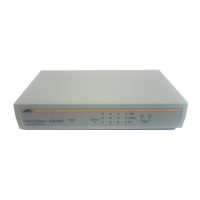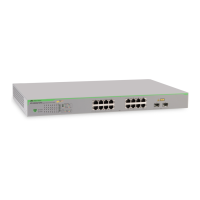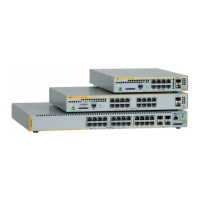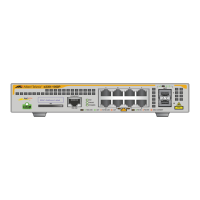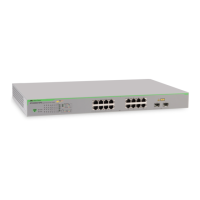802.1w Rapid Spanning Tree
The Switch implements three versions of the Spanning Tree Protocol, the Multiple Spanning Tree Protocol (MSTP) as defined by the IEEE 802.1s, the Rapid
Spanning
Tree Protocol (RSTP) as defined by the IEEE 802.1w specification and a version compatible with the IEEE 802.1d STP. RSTP can operate with legacy
equipment implementing IEEE 802.1d, however the advantages of using RSTP will be lost.
The IEEE 802.1w Rapid Spanning Tree Protocol (RSTP) evolved from the 802.1d STP standard. RSTP was developed in order to overcome some limitations of
STP that impede the function of some recent switching innovations, in particular, certain Layer 3 functions that are increasingly handled by Ethernet switches.The
basic function and much of the terminology is the same as STP. Most of the settings configured for STP are also used for RSTP. This section introduces some new
Spanning Tree concepts and illustrates the main differences between the two protocols.
Port Transition States
An essential difference between the three protocols is in the way ports transition to a forwarding state and in the way this transition relates to the role of the
port (forwarding or not forwarding) in the topology. MSTP and RSTP combine the transition states disabled, blocking and listening used in 802.1d and creates a
single state Discarding. In either case, ports do not forward packets. In the STP port transition states disabled, blocking or listening or in the RSTP/MSTP port
state discarding, there is no functional difference, the port is not active in the network topology.Table 6-1 below compares how the three protocols differ
regarding the port state transition.
All three protocols calculate a stable topology in the same way. Every segment will have a single path to the root bridge.All bridges listen for BPDU packets.
However, BPDU packets are sent more frequently – with every Hello packet. BPDU packets are sent even if a BPDU packet was not received.Therefore, each link
between bridges is sensitive to the status of the link. Ultimately this difference results in faster detection of failed links, and thus faster topology adjustment.A
draw-back of 802.1d is this absence of immediate feedback from adjacent bridges.
802.1d MSTP 802.1w RSTP 802.1d STP Forwarding Learning
Discarding Discarding Disabled No No
Discarding Discarding Blocking No No
Discarding Discarding Listening No No
Learning Learning Learning No Yes
Forwarding Forwarding Forwarding Yes Yes
Table 6- 2. Comparing Port States
RSTP is capable of a more rapid transition to a forwarding state – it no longer relies on timer configurations – RSTP compliant bridges are sensitive to feedback
from other RSTP compliant bridge links. Ports do not need to wait for the topology to stabilize before transitioning to a forwarding state. In order to allow this
rapid transition, the protocol introduces two new variables: the edge port and the point-to-point (P2P) port.
Edge Port
The edge port is a configurable designation used for a port that is directly connected to a segment where a loop cannot be created. An example would be a port
connected directly to a single workstation. Ports that are designated as edge ports transition to a forwarding state immediately without going through the
listening and learning states.
An edge por
t loses its status if it receives a BPDU packet, immediately becoming a normal spanning tree port.
P2P Port
A P2P por
t is also ca
pable of ra
pid transition. P2P ports may be used to connect to other bridges. Under RSTP/MSTP, all ports operating in full-duplex mode are
considered to be P2P ports, unless manually overridden through configuration.
802.1d / 802.1w / 802.1s Compatibility
MSTP or RSTP can interoperate with legacy equipment and is capable of automatically adjusting BPDU packets to 802.1d format when necessary. However, any
segment using 802.1d STP will not benefit fr
om the ra
pid transition and ra
pid topolog
y change detection of MSTP or RSTP
.
The pr
otocol also provides for a
variable used for migration in the event that legacy equipment on a segment is updated to use RSTP or MSTP.
The Spanning Tree Protocol (STP) operates on two levels:
1.
On the s
witch le
v
el,
the settings ar
e globall
y implemented.
2.
On the por
t le
v
el,
the settings ar
e implemented on a per user
-defined gr
oup of ports basis.
STP Bridge Global Settings
To open the following windo
w
, open the
Spa
nning T
r
ee
f
older in the
Configur
ation
men
u and click the
STP Br
idge Gl
obal Settings
link.
43
Allied Telesyn AT-9724TS High-Density Layer 3 Stackable Gigabit Ethernet Switch

